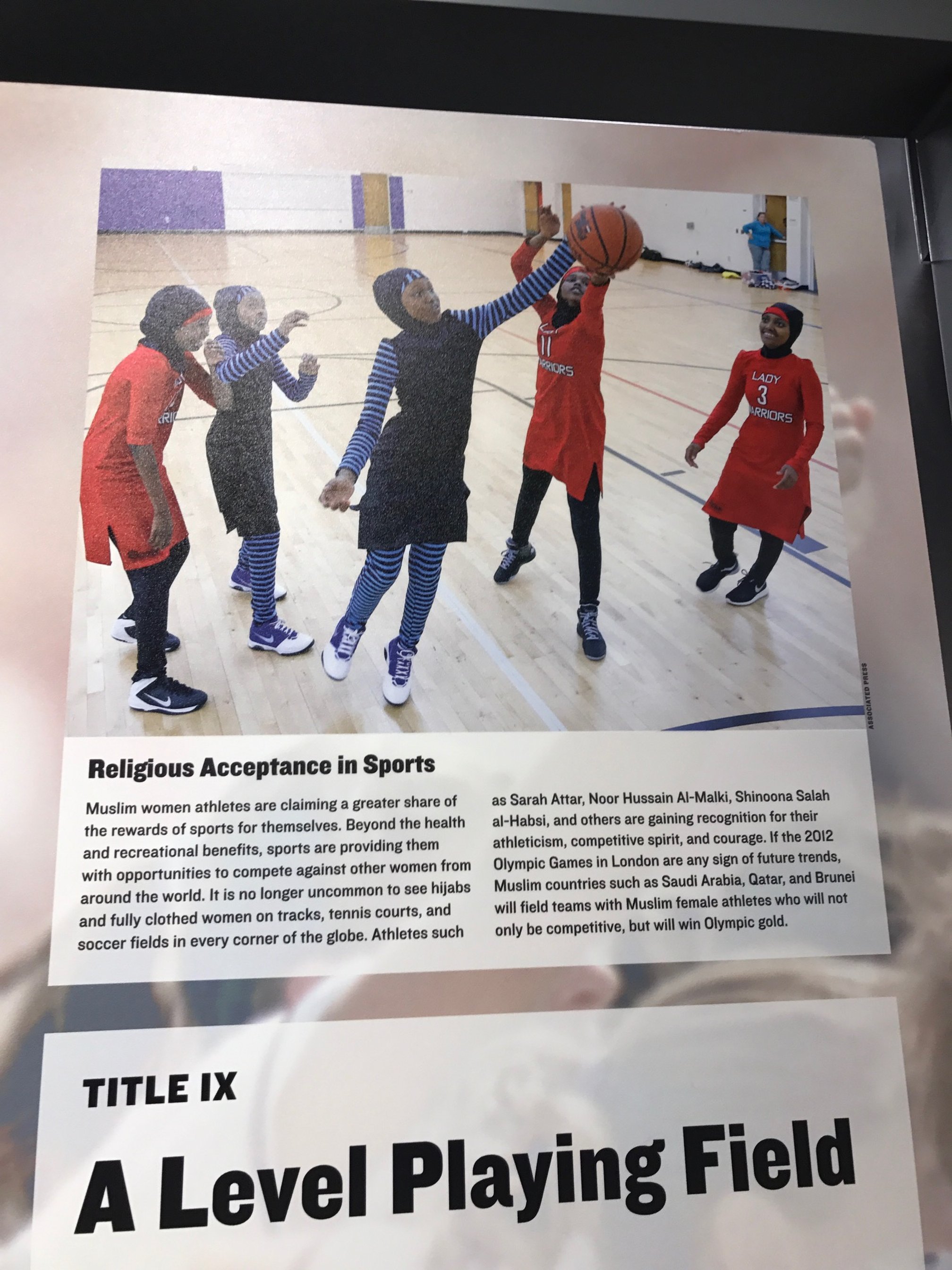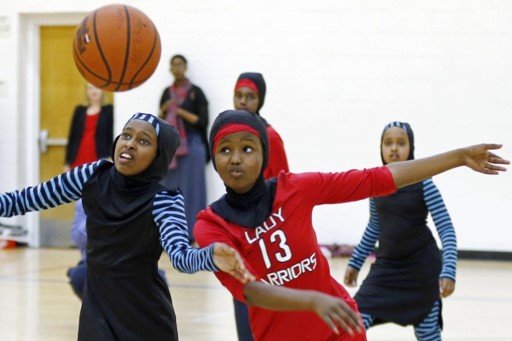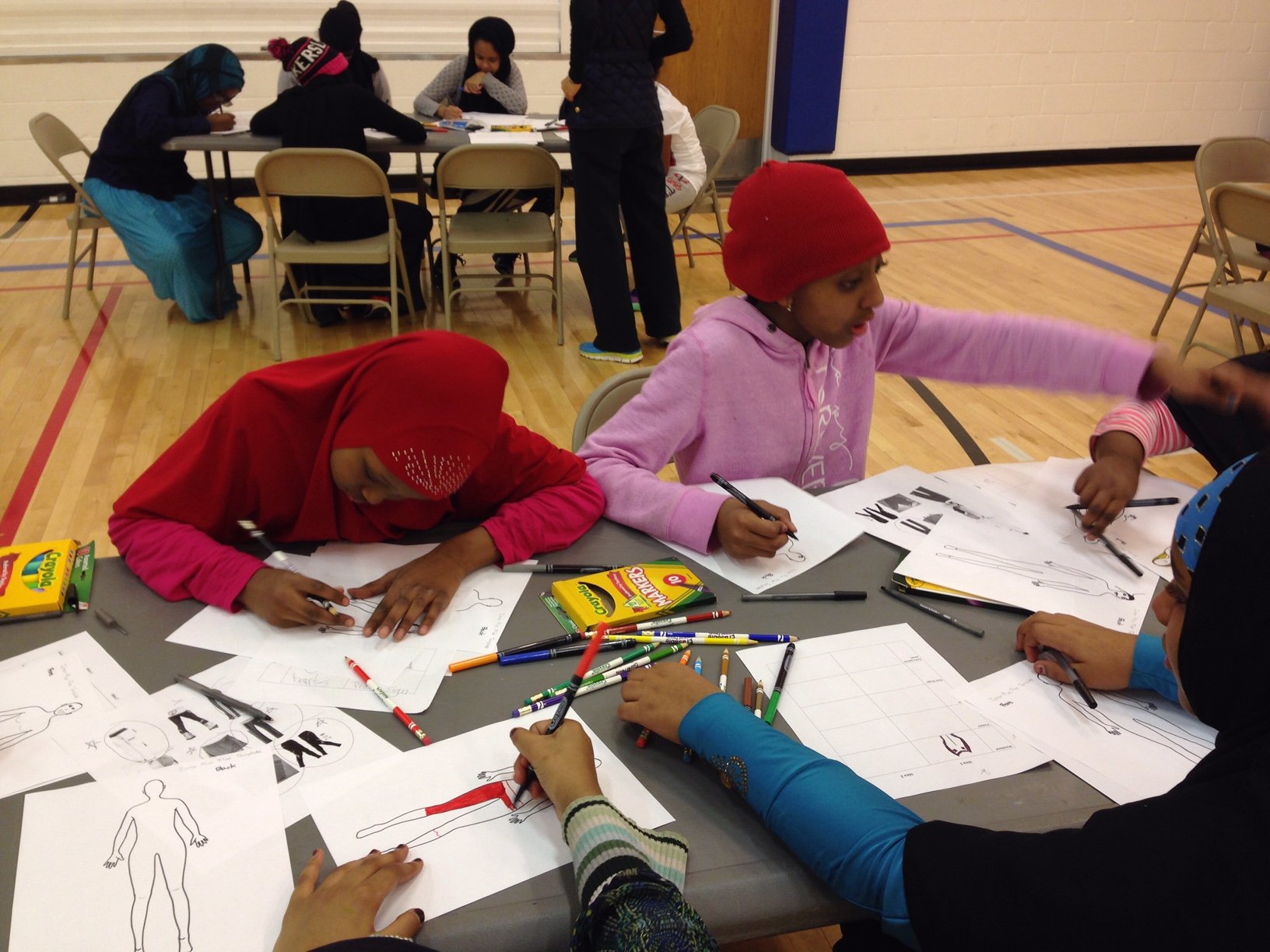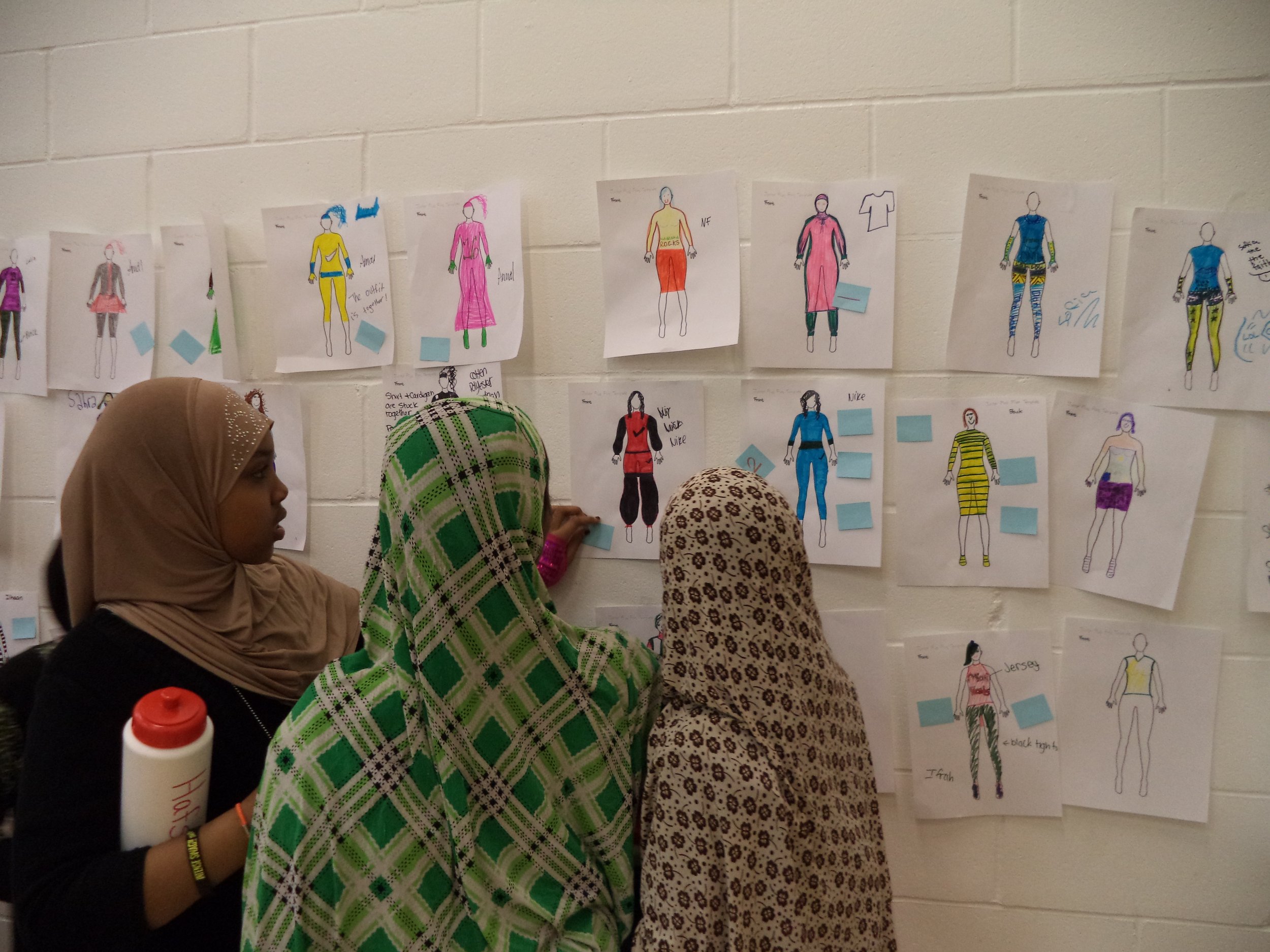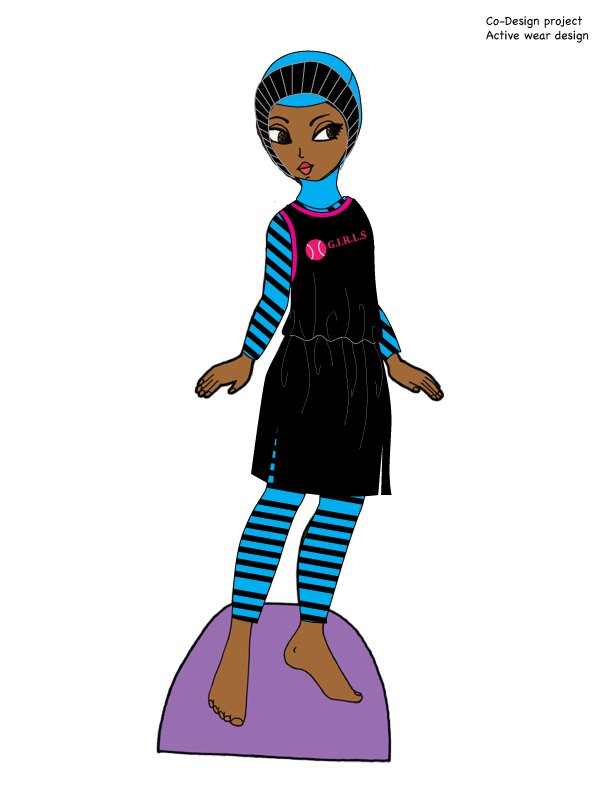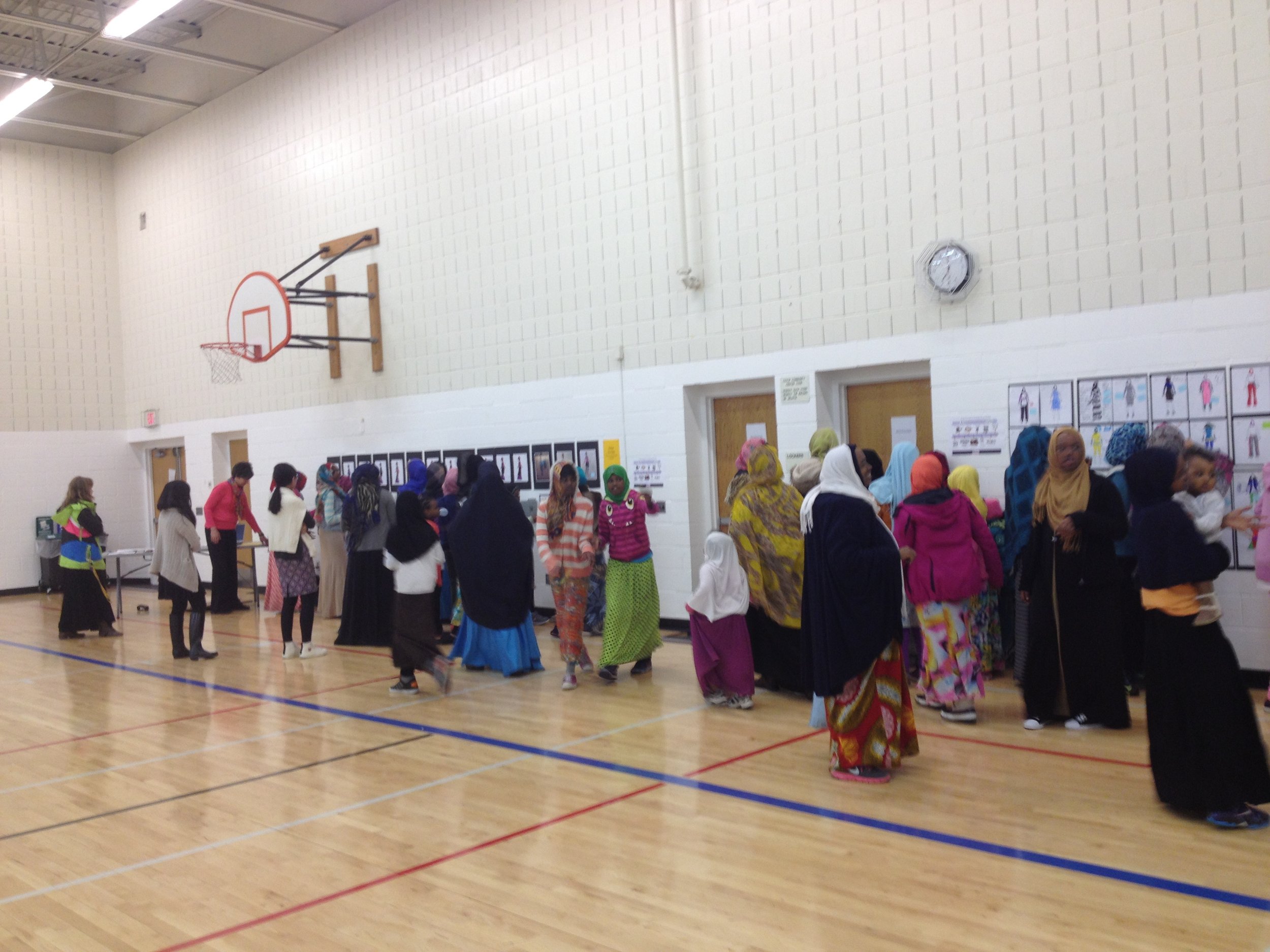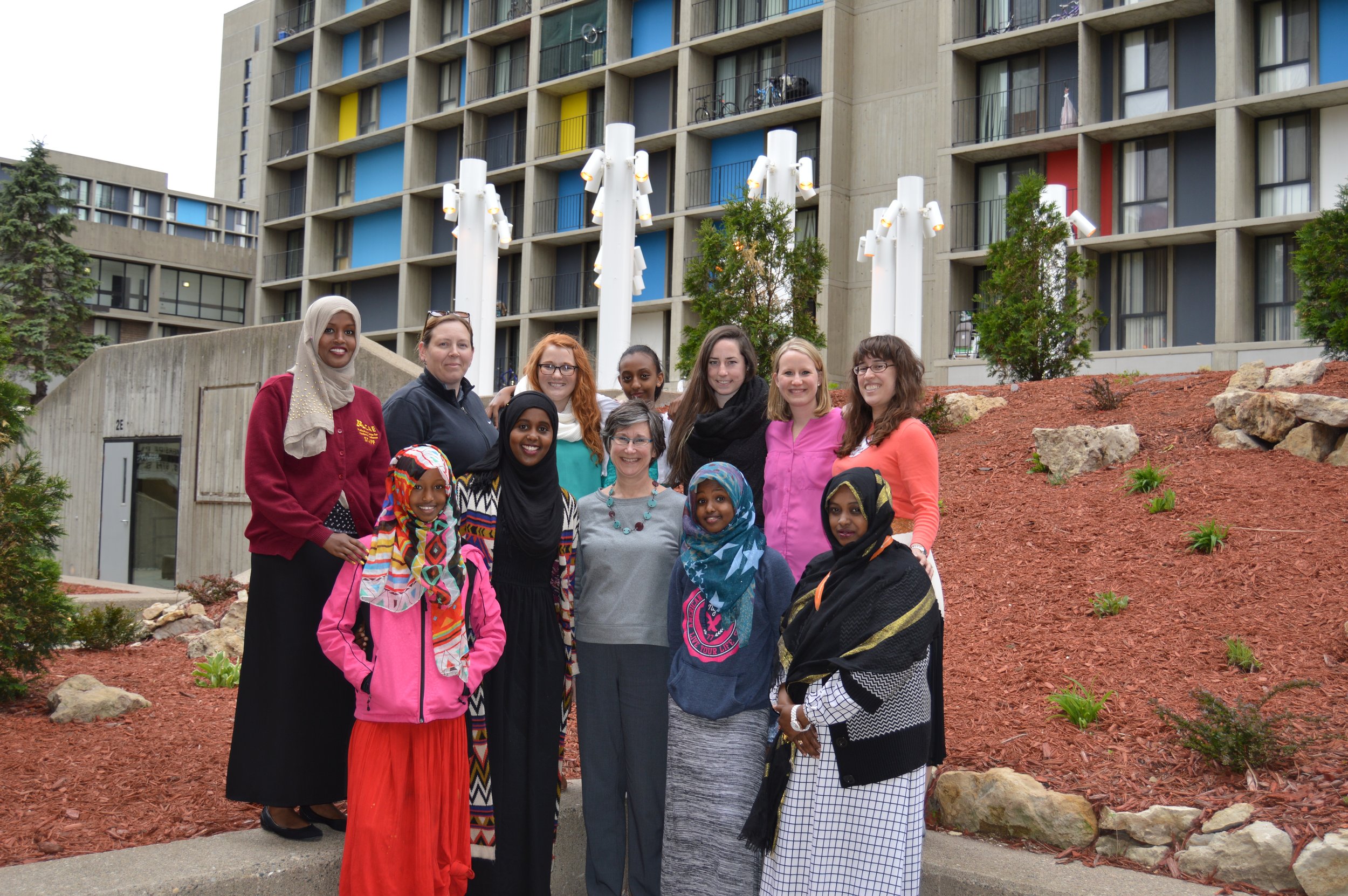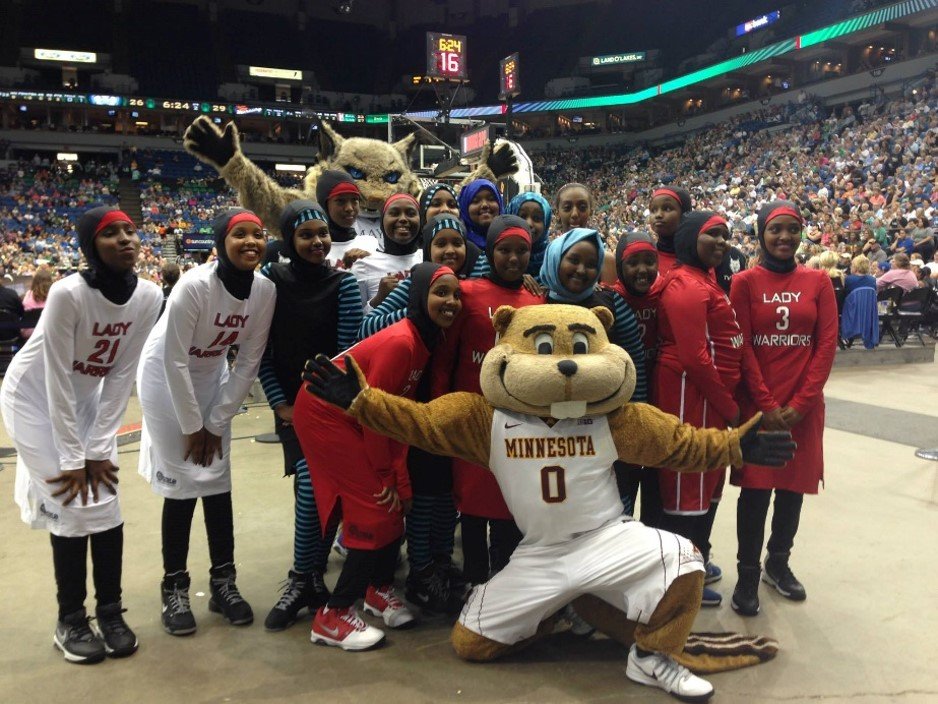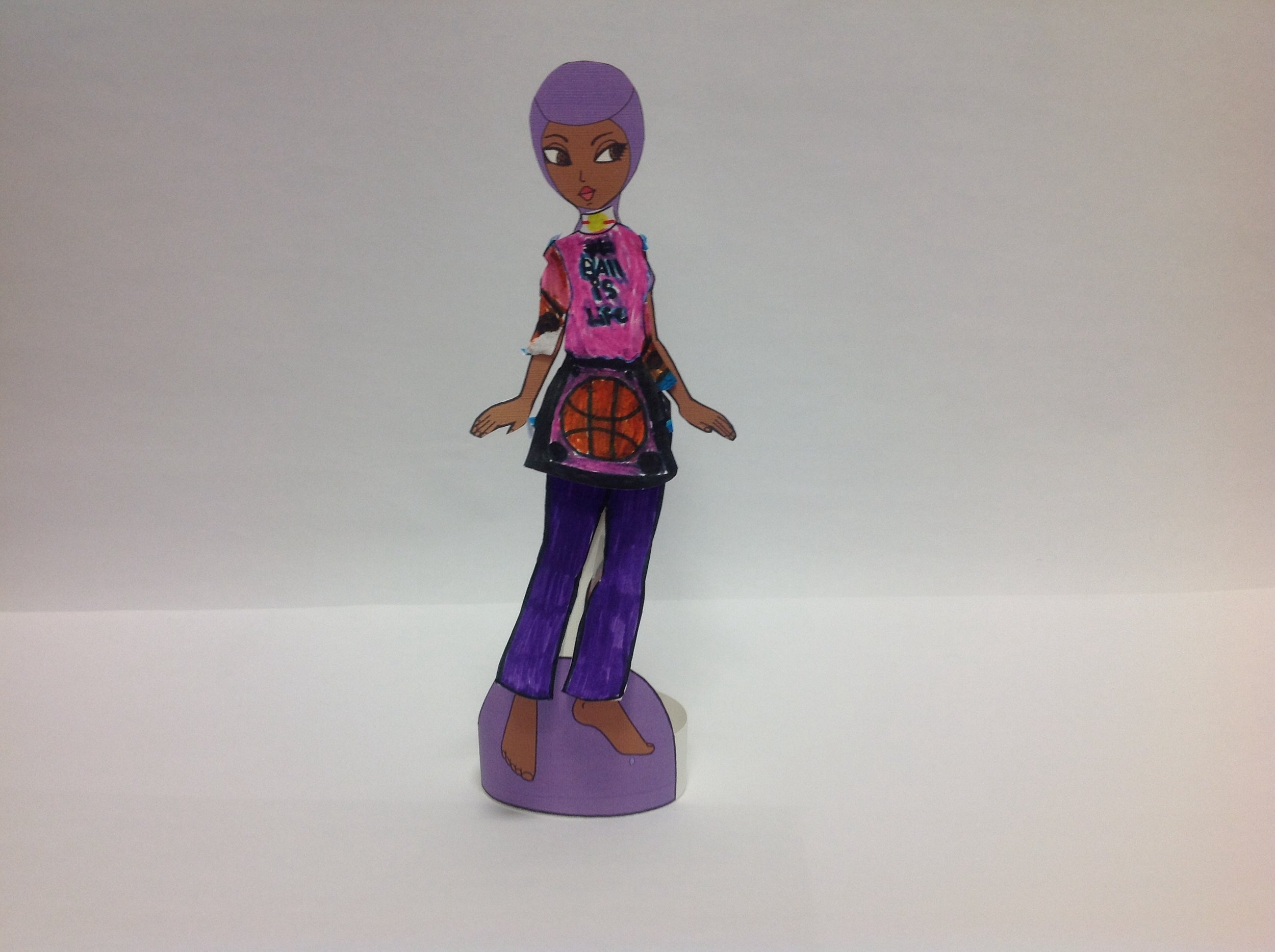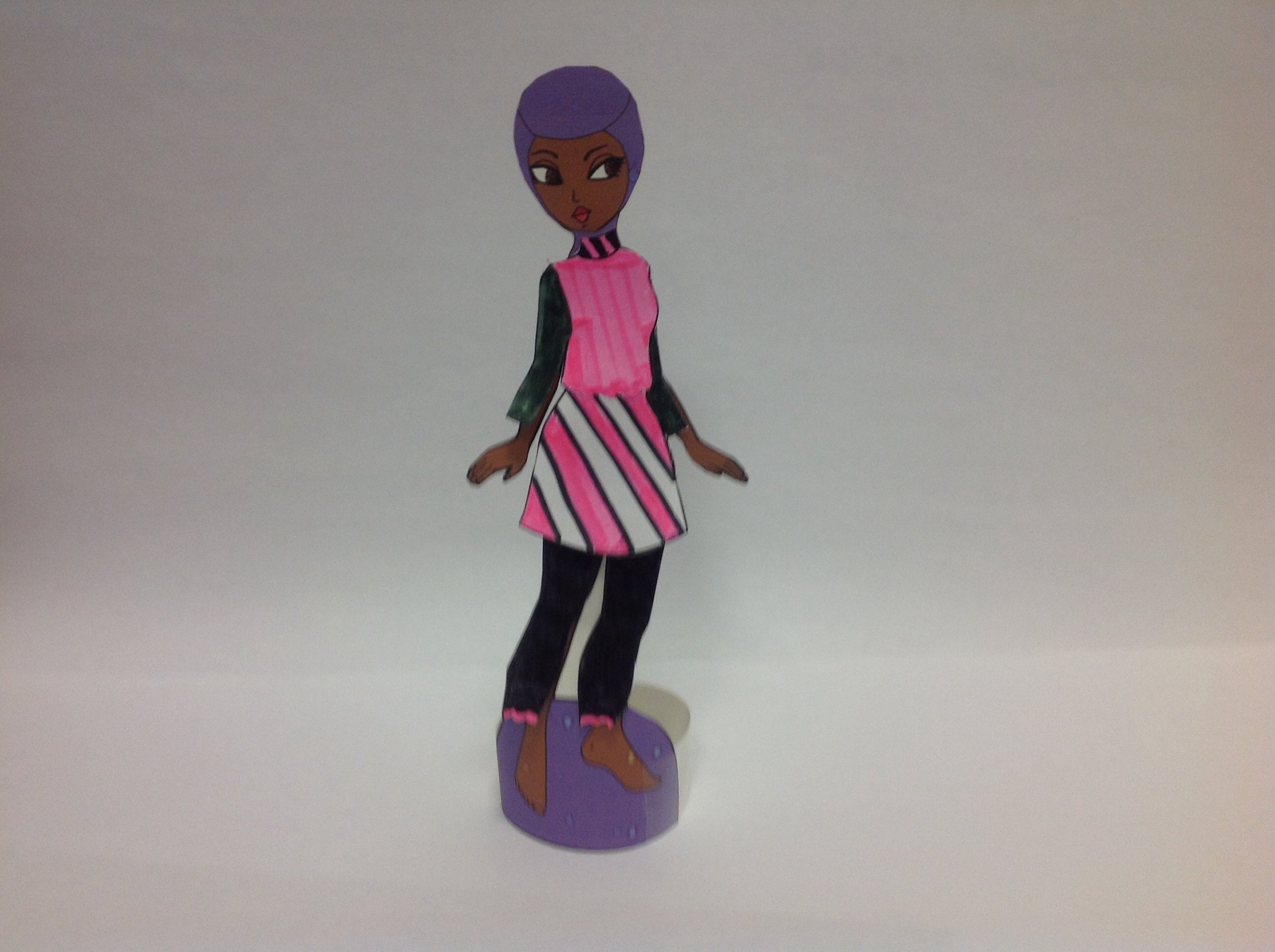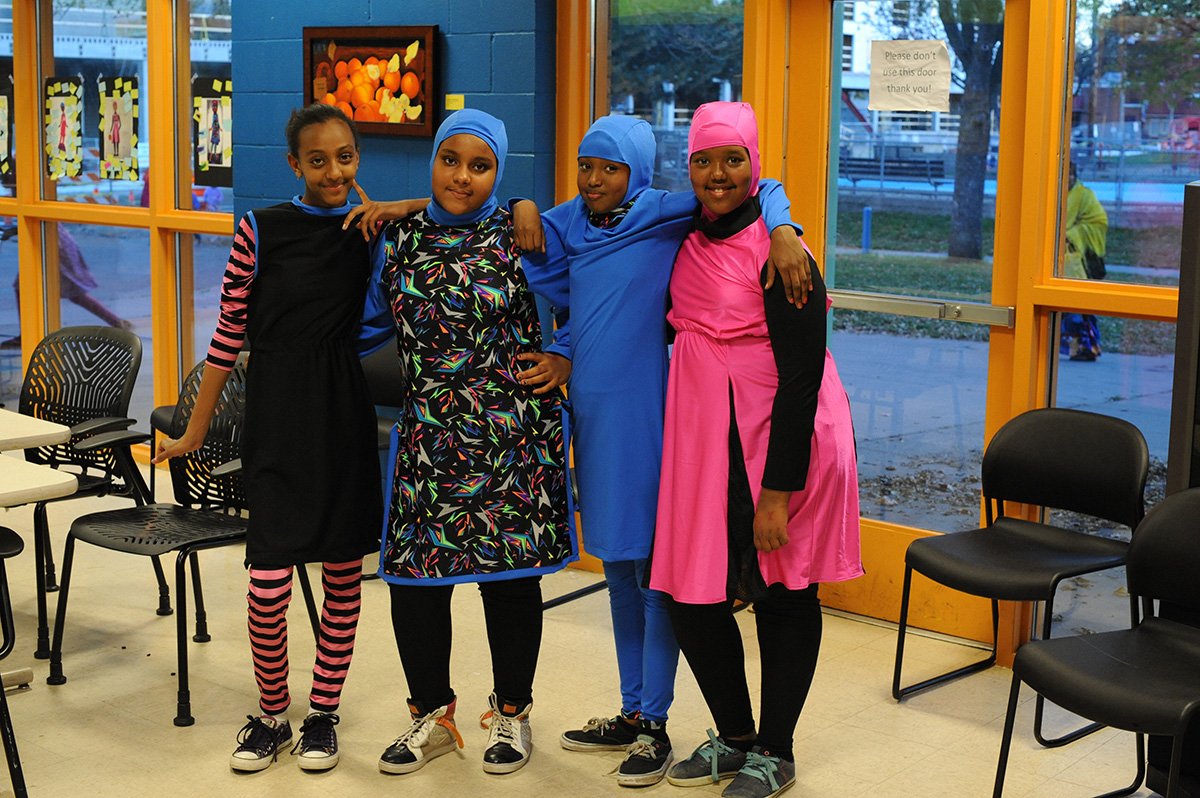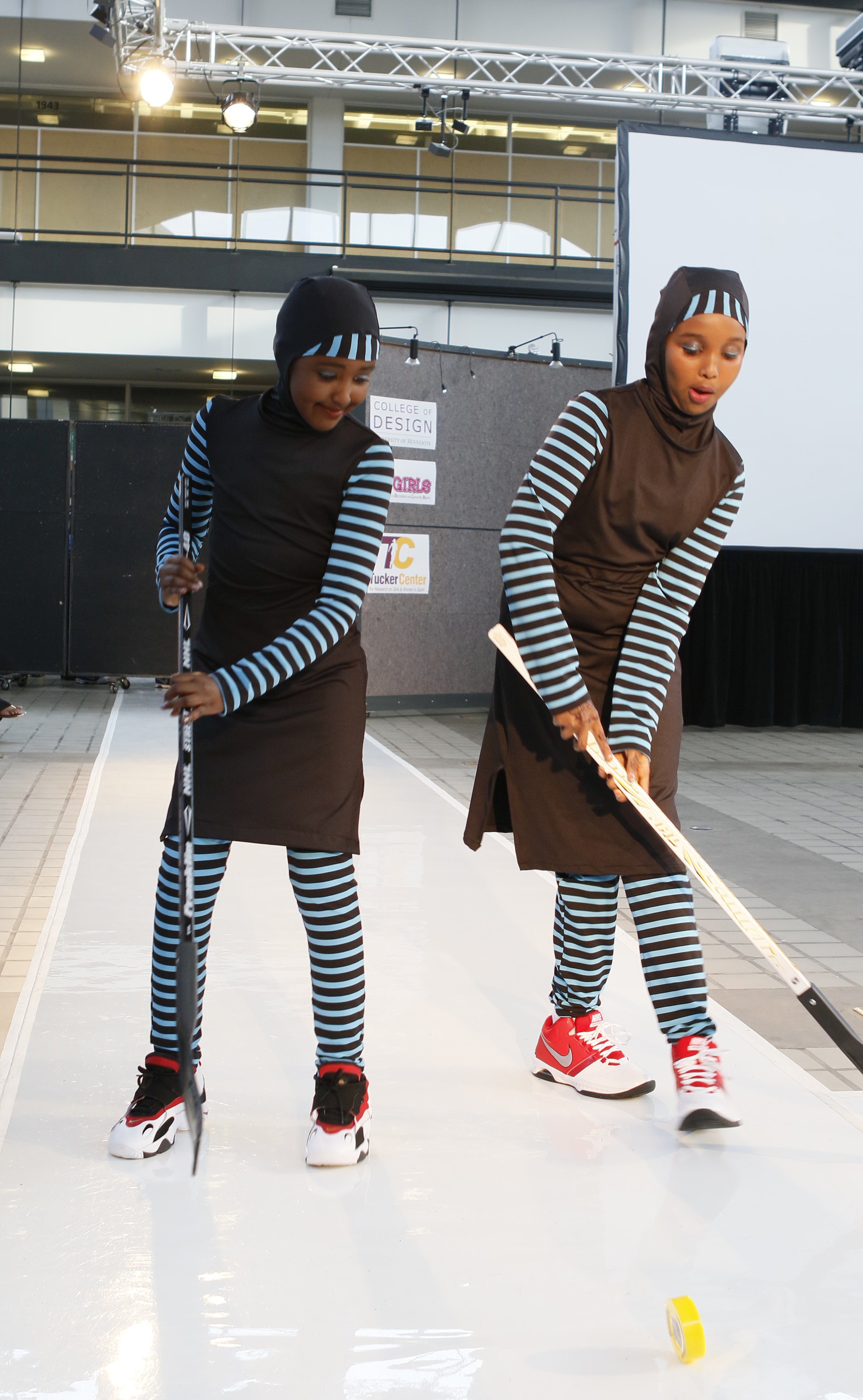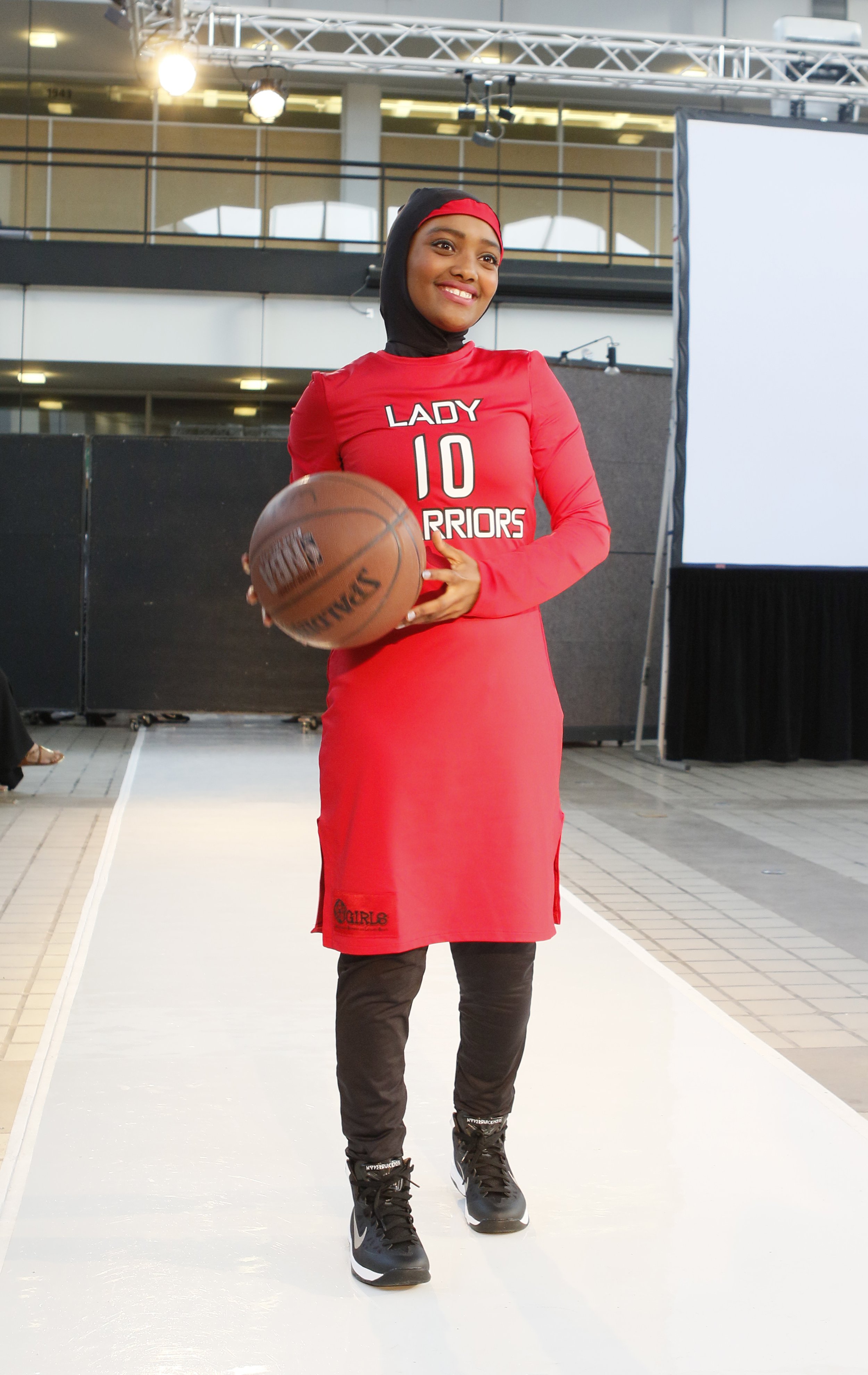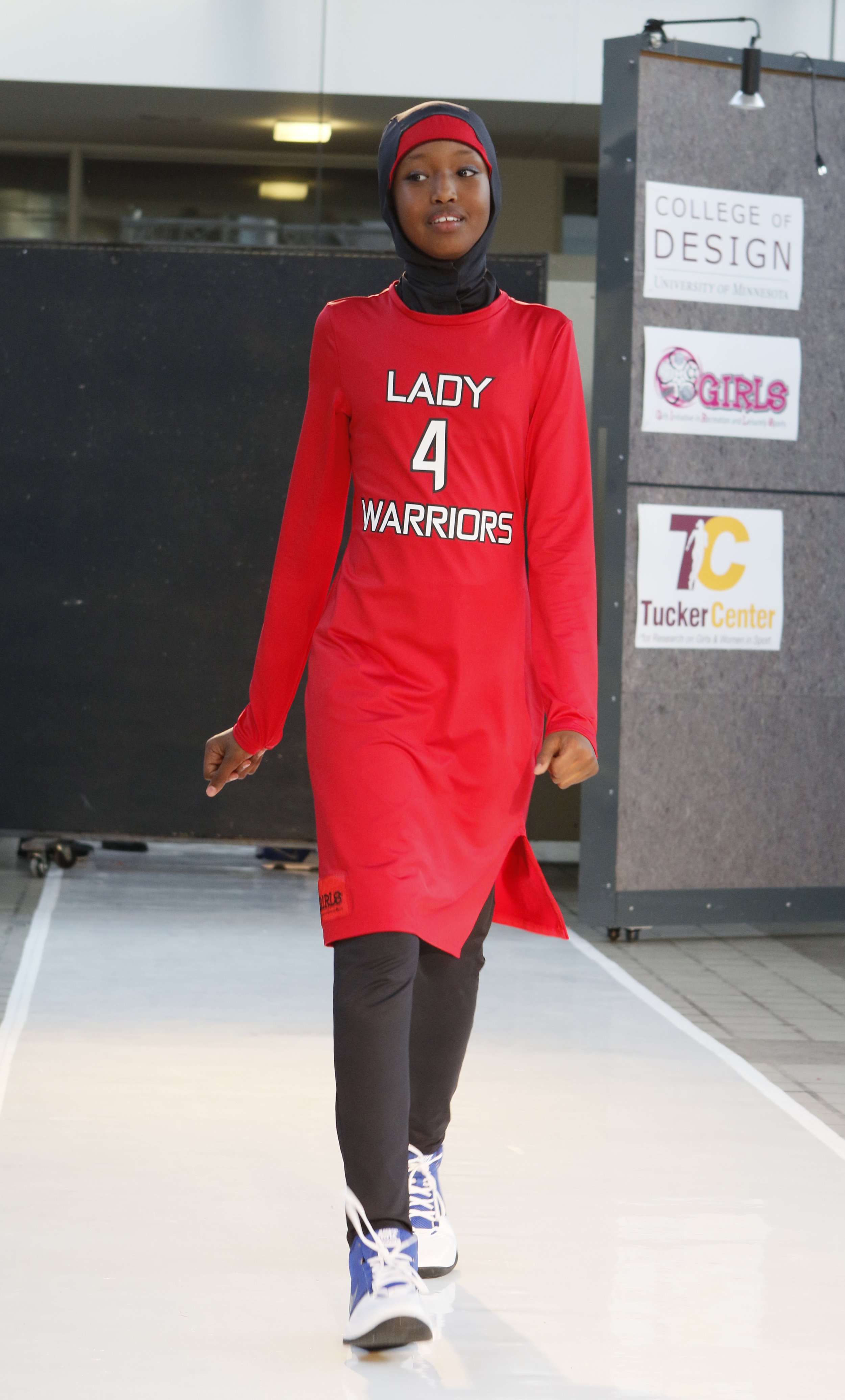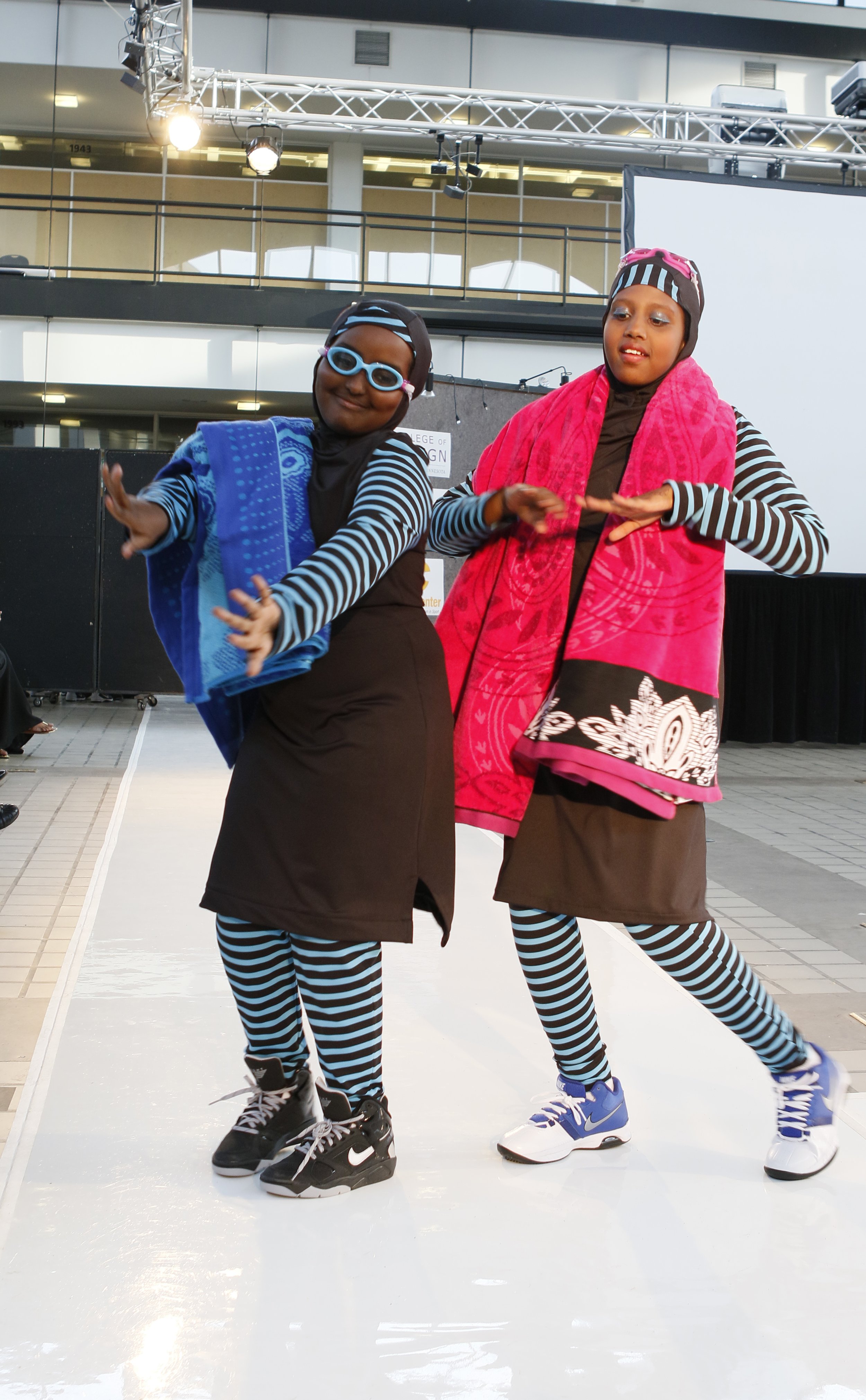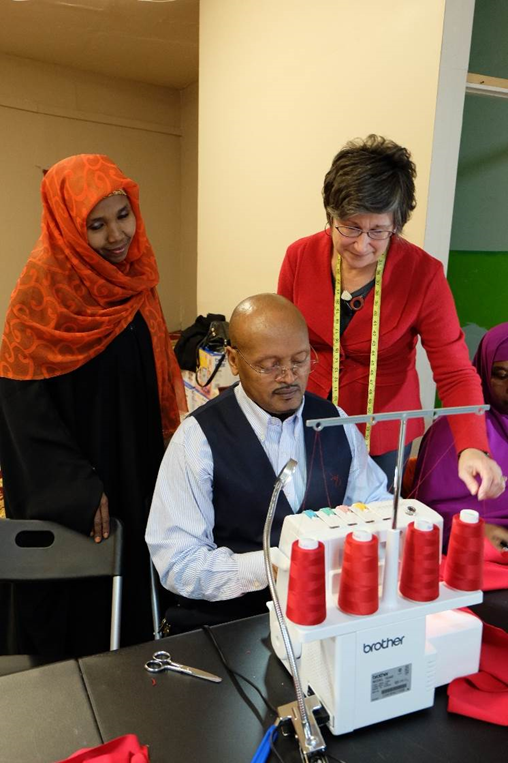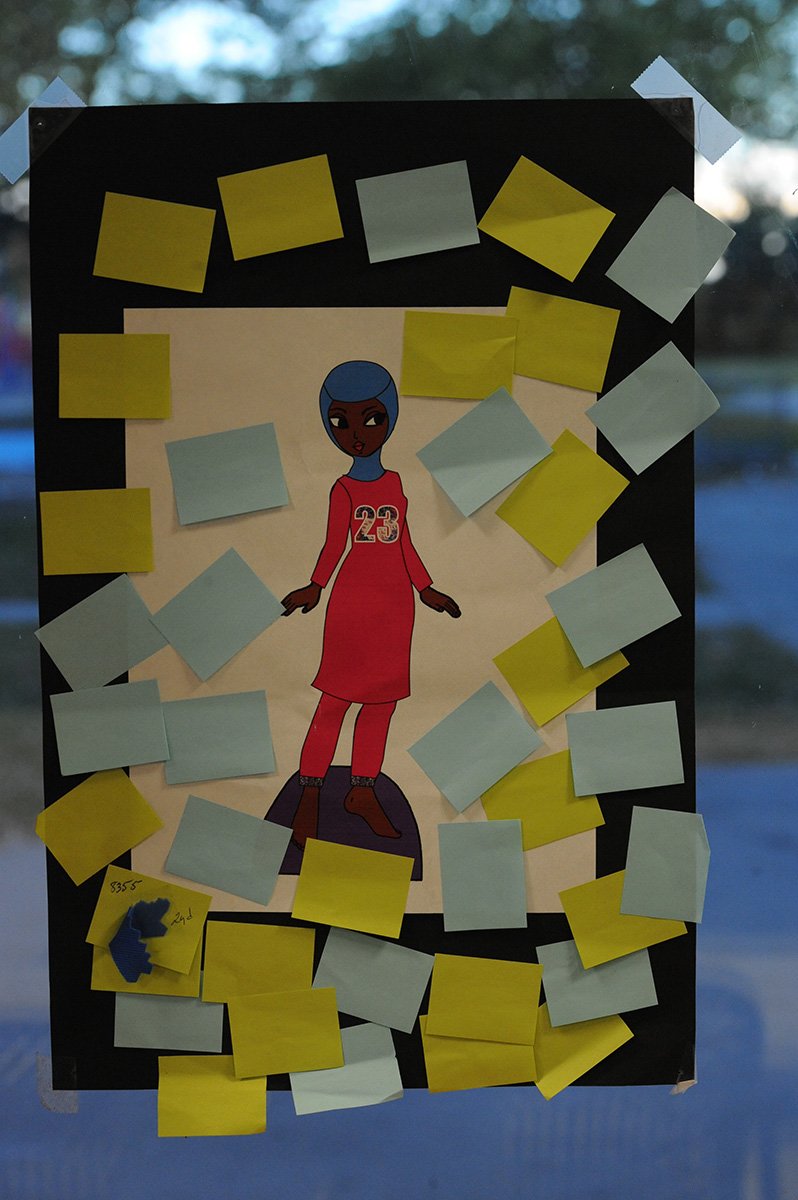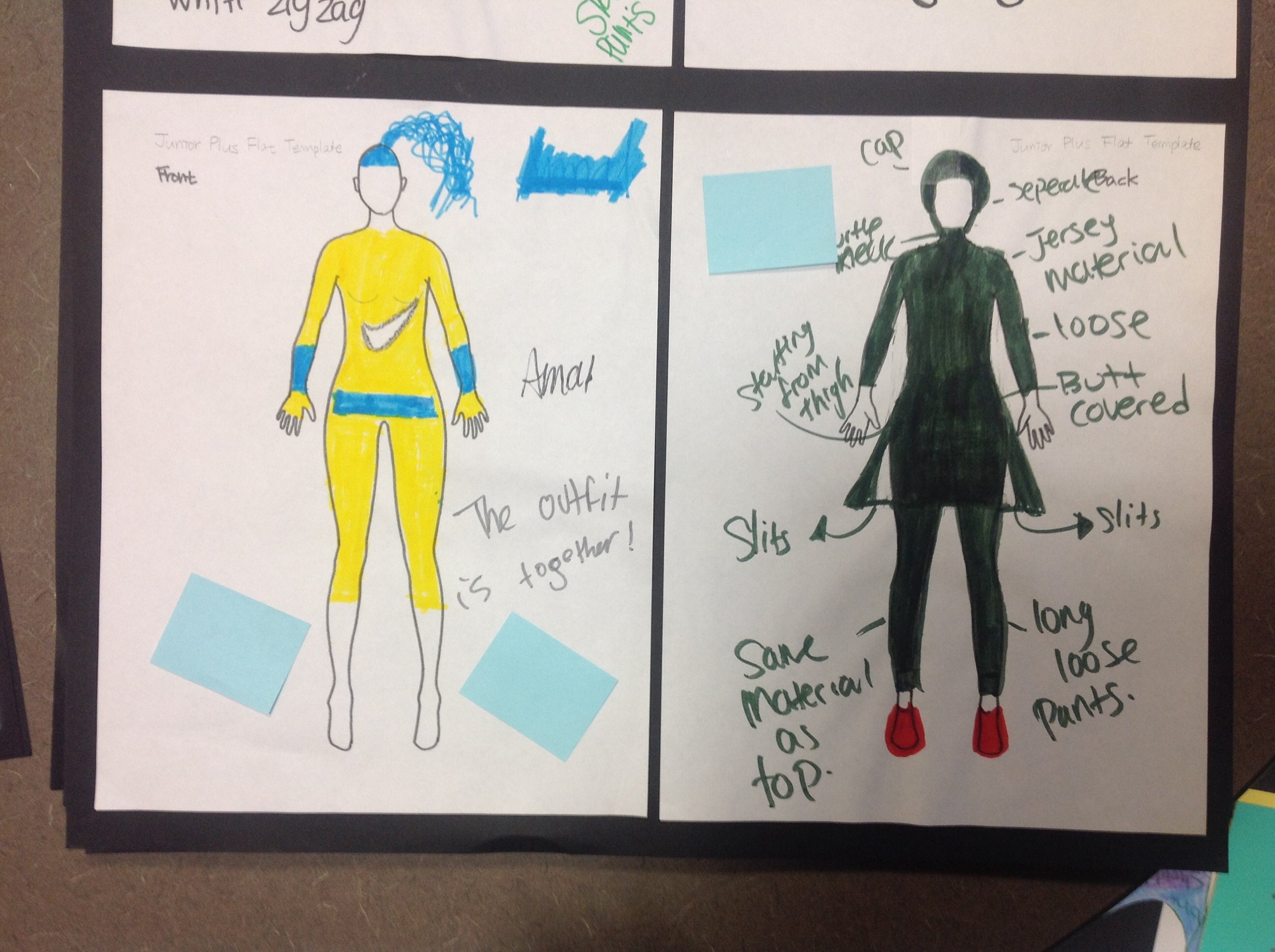Co-Design for Community: Producing Culturally Appropriate Athleticwear with the GIRLS Project
Modest athleticwear that meets the needs and desires of adolescent girls is difficult to find and rarely affordable. The GIRLS Community co-design project, initiated at the University of Minnesota, supported East African middle and high school girls (of Somali, Oromo, and Ethiopian descent) in designing and producing culturally appropriate athleticwear. Their goal was to participate in physical activity and sport experiences—especially basketball—in public and mixed-gender spaces. This involved key partners from within the community who supported the project, provided feedback, and produced the garments. During an end-of-project fashion show, the girls shared the positive impact of the co-design process and resulting garments, describing the process as “empowering” and asserting that in the garments “I can be who I am and just play.” The project involved faculty, students, and community groups, with funding from the university extension service.
GIRLS Project
The girls, most of whom are practicing Muslims, wanted to participate in physical activities in public and mixed gender spaces, and especially to play basketball. They wanted something to wear that would boost their performance on the court, look cool, meet their cultural and religious beliefs of modesty, and meet the approval of their parents and the community. Their faith and cultural values were central to their lives in their Minneapolis immigrant neighborhood. While in public and mixed gender spaces, the girls chose modest dress, fully covering their bodies in long skirts, long sleeve tops, and a hijab, as well as athletic shoes and leggings. This ensemble presented challenges during physical activities.
The girls described moments of having to choose between being who they are and just playing. For example, they shared that if they were dribbling down the court and their hijab started to loosen, they would have to choose whether to fix their hijab (an important part of who they are) and risk losing the ball (sacrificing performance) or continue with the ball (maintaining performance) and risk their hijab falling off (sacrificing a key aspect of their identity). Many of the girls wanted to play basketball on their school teams, and especially a traveling basketball team. They had concerns that there was no modest uniform option for them to do so comfortably, safely, and in a culturally appropriate fashion. They felt limited by available times for “girls only gym” and more traditional community values that did not prioritize girls’ sports. Fortunately, many participated in the GIRLS program, an all-female, community-based physical activity program that was established to create a safe space for young Muslim girls to be physically active while respecting faith and cultural values. It was founded and supported by several women in the community who saw the importance of physical activity and girls’ sports to foster healthy, collaborative future leaders. These partners were seriously committed to the girls and volunteered their time and talents in sports, coaching, mentoring, and creating opportunities. What happened next can only be described as serendipity, and a story of partnership.
“The GIRLS leadership team regularly participated in the Co-Design leadership team meetings; each had a seat at the table, a decision-making vote, and a platform to share the ideas of the collective GIRLS participants.”
The girls’ voices were heard when one of the GIRLS program partners, Chelsey, a postdoctoral fellow at the University of Minnesota (UMN), an affiliated scholar in the Tucker Center for Research on Girls & Women in Sport, and a long-standing program volunteer, reached out to Missy, a UMN Apparel Design professor. Chelsey shared the girls’ desire for clothing that allowed them to play sports more comfortably and safely while respecting their faith and cultural practices. There was nothing on the market specifically designed for adolescent girls. The mature styles, colors, and sizing did not work for the girls and the cost presented an additional barrier. This was the gap we aimed to fill with the girls’ ideas about what would work for them with the support of their community.
The commitment and enthusiasm were immediate and while they talked, a recent request for proposals from the UMN Extension Office was noted. We, along with Nicole, Associate Director of the Tucker Center, submitted the proposal in less than a month while simultaneously reaching out to the community to form additional partnerships. We received the grant and began a life-changing “Co-Design” project with the girls and their community. Ehrenfeld describes design as “a conscious, deliberate effort to change the systemic presuppositions—[the] beliefs and normal practices…—underlying action so that the desired end may be attained.” [1] Our approach to building partnerships with the girls, their families and community, an Imam and the cultural center he led, and the media were as essential to the success of the project as the garments.
First, we developed the Co-Design leadership team consisting of community and university members. The community leaders were already girls’ physical activity advocates and trusted in the community. [2] A core goal of the project was to include community participation and especially the girls’ voices as a central part of the decision making. The GIRLS leadership team regularly participated in the Co-Design leadership team meetings; each had a seat at the table, a decision-making vote, and a platform to share the ideas of the collective GIRLS participants. There were also more community than university members on the leadership team in order to support a more equitable distribution of power and to ensure significant value was placed on community in addition to academic knowledge. We were intentional about rotating meeting locations between the community and the University.
The large project team included a wide range of partnerships in itself. In addition to the four girls on the leadership team, there were 20 girls from the GIRLS program who participated in the project. Seven Apparel Design students provided project support. The Brian Coyle Neighborhood Center, the Cedar Riverside Community School, and the Riverside Islamic Center were foundational partners as they provided the community spaces for meetings, gatherings, physical activities, and garment production. They were located in the center of the community, which made them accessible and symbolic of the critical importance of community as the heart of this project.
The process of building community among the project team began in earnest with regular meetings that always included sharing a snack or a meal. Mac and cheese pizza was a favorite! We planned activities to get to know each other, build trust, and learn about designing for girls’ physical activities. These included trying new sports and thinking about the functionality of athleticwear (designed for a range of activities), attending a UMN women’s basketball game where the girls observed how the uniforms (designed for a specific team) facilitated movement, visiting the Apparel Design program with a 3D body scanner and the Goldstein Museum of Design to look at athleticwear from the past, and visiting the Tucker Center to learn about conducting girls’ physical activity and sport research. Often mothers and a few siblings came along and expanded our growing community. One morning the GIRLS leadership team attended a presentation on innovation in women’s sport apparel and equipment by an Apparel Design alumnus who was a Design Director at Nike. This reinforced the concept that the Co-Design project the girls had started was innovative! All GIRLS participants attended the annual Apparel Design fashion show and toured behind the scenes, quickly deciding that they would like to have their own show at the conclusion of the project.
Next, the girls got to work learning about the design process and sharing their ideas. The activities for each week were developed and adapted based on the outcomes of the previous week. Flexibility became our mantra with so many people and factors involved. One of the first steps was to set up criteria for the garments and understand the girls’ needs and wishes. Some of the top items were ‘comfortable,’ ‘modest,’ ‘pink,’ and ‘cute.’ One evening the girls made mood boards for inspiration and used croquis to draw out their ideas. Another time we dressed paper dolls. We gathered as a group at the end of every session to share feedback on the ideas the girls had posted on the wall of the gym. Sometimes the girls had five dots to place on the pictures to vote for their favorite designs. This approach worked well to make the collective opinion visible while remaining anonymous.
“User-led design views inclusivity as a moral and ethical commitment to improving the alignment between the used and the designed tool.”
The members of the project team who were not familiar with the girls’ cultural and faith practices had a steep learning curve. While we tried to be respectful and inclusive, our inexperience caused a few bumps along the way. For example, the team listened to comments from parents who were concerned about the modesty of the croquis and paper dolls. In response, the croquis were simplified to an outline of the body with any indication of breasts or curves removed. The original brown skin paper doll wore a bandeau top and bikini bottoms which were replaced with solid white ‘underwear’ that left only the face, hands and feet exposed. This is an example of user-led design that views inclusivity as a moral and ethical commitment to improving the alignment between the user and the designed tool. [3]
The girls developed wonderful, creative ideas that became the basis for the final designs. Feedback from the girls, their parents, and the votes informed a collection of semi-final designs drawn by the Apparel Design students.
We held two Gallery Walks and invited families and friends, key partners, and respected leaders in the Muslim community. We knew how important it was to have the support of leaders and the community, both to ensure a true collective community approach and because the girls would be wearing the new athleticwear in the neighborhood. It was important for them to see the girls’ work that led up to the proposed designs, ask questions, give feedback, enjoy refreshments, and vote (using the dot method again) for their favorite designs. “In this project, there is community ownership. It’s hugely important in this process [that] our girls [have] this vehicle to present and compete. … Whether it’s choosing it, designing it, that’s bigger than anything I’ve ever seen in this community. Usually, we see programs designed for us, and we’re not part of the process,” Abdirizak Bihi, father of one of the young designers, said. [4] At the end of the evening, the top four designs were identified. Prototypes of the designs were made to fit the GIRLS’ Leadership group.
During the second Gallery walk, the four girls on the leadership team modeled the designs and we collected feedback and votes for the community favorite. This time the girls shared how the athleticwear felt and how easy it was to move while doing physical activities, especially playing basketball. No one was shy about sharing their opinions, which was a good sign that trust had been established. Several of the mothers shared that the blue in one of the outfits reminded them of the Somalian sky. They commented that the fit should be looser and the length longer and wanted to know how to wash the outfits. Most of all they wanted to know when we could help them design athleticwear for themselves and their younger daughters!
“The athleticwear design included a knee length tunic with an elastic waist, side slits, and long sleeves, a loose fitting pair of leggings, and a close fitting/easy release head covering.”
In a following leadership meeting, while discussing the budget, we realized that there was some additional funding. Collectively a solution to create culturally sensitive sport uniforms based on the athleticwear was formed. The girls were excited about the opportunity to play on a traveling team. Muna could relate to the girls’ experience, as she had also struggled to find modest athleticwear. After all the excitement, she went home to start developing ideas for the sport uniforms. In collaboration with Coach Weber, the duo created the Lady Warriors, the first traveling basketball team in the neighborhood.
The athleticwear design included a knee length tunic with an elastic waist, side slits, and long sleeves, a loose fitting pair of leggings, and a close fitting/easy release head covering. The blue and black striped/solid knit fabric was a polyester/spandex blend developed to wick away moisture. The sport uniforms used the same pattern without the waist elastic. The tunics were made in both red and white to signify home or away court status. They also were emblazoned with the team name and player number. With the final designs selected, we prepared for production. Our partnership with the Imam at the Riverside Islamic Center provided a private space we could rent and where we could set up a production center. In a large light-filled room, we set up seven sewing machines, an ironing station, and a quality control station. We set up and took down the equipment for each session as the space was needed for events.
Community and collaboration were a key part of the project, thus, to continue ongoing efforts to include community members, local East African sewers were recruited to take a skills test. This resulted in hiring five sewers. Due to language barriers between the leadership team and sewers, two translators were hired to facilitate communication. Over six weeks, the production team worked hard and enjoyed the twice-weekly gatherings. When the call for prayer sounded, people could take a break and participate. Even with language barriers, we got to know and respect one another. Our last evening was a celebration with a meal from a local community restaurant.
During the production period, the girls continued with different sports experiences. They participated in sessions with the Minnesota Machine (a women’s tackle football team), and instructors at Fred Wells Tennis & Education Center. They also attended a UMN women’s softball game. The purpose of these events was to continue building community, provide exposure to female athlete role models, and provide additional opportunities to try and observe new sports in which they might consider participating in the future with their new athleticwear. We were also preparing for the fashion show which was to be our big community celebration and the culminating project event.
The girls worked with several Apparel Design students and a show coordinator to plan and choreograph the fashion show that was held on the UMN campus. Everyone who contributed to the project was invited to the show and it was open to the public. The show featured the final athleticwear and Lady Warrior uniforms for the first time! The girls put together mini sports demonstrations with music they had selected. They walked the runway with boxing gloves, tennis rackets, footballs, and basketballs! The girls on the leadership team were the Masters of Ceremony, welcoming everyone, explaining the project, and thanking everyone. A highlight was when they shared what the project process and resulting athleticwear meant in their own lives and what they hoped it would mean in many more girls’ lives to come. They talked about their hope for a future where inclusive, culturally sensitive activewear and sport uniforms are the norm, not the exception, so all girls can truly be who they are and just play. They talked about the dream of one day walking into a store and seeing a choice of athleticwear that met their cultural and aesthetic wishes. Additional community and university leadership team members spoke briefly, though it was by and large girl-centered. The evening wrapped up with refreshments. It felt as if the entire community was celebrating because they had contributed to the success of the two-year project.
The show was wildly successful and led to a wide variety of local, national, and international press. Over 40 unique news outlets reported on the project. This was happening around the same time as the story broke about the amateur boxer Amaiya Zafar who won her petition to wear a hijab in the ring from USA Boxing. We received requests for interviews, inquiries about buying the activewear, and praise for the girls who initiated the idea and stayed with the project. The girls were honored at halftime of a MN Lynx women’s basketball game. On National Girls and Women in Sports Day, the leadership team was presented with a 2016 Breaking Barriers Award for their work in dismantling barriers to physical activity programming.
The sixth grade girls from the community were able to participate in the first traveling team with both home and away uniforms from the project. The project was featured at the Muhammad Ali Center in Louisville, Kentucky. One of the uniforms and documentation about the project are artifacts at the Minnesota History Museum. The athleticwear was passed along to siblings and neighbors when it was outgrown. A follow up with the girls found that they were now adopting knee length skirts (the same length as the tunics) over their regular leggings. They had successfully changed perceptions in the community about what was acceptable athleticwear for teens and sparked ongoing initiatives to advance East African Muslim girls in sports opportunities.
Conclusion
This was a true community-university, youth-engaged project. It was a project with the girls and the community, not on or for the girls and community. Together we recognized the essential value of lived experience and knowledge. We kept the focus on the girls, using their spirit and goals to keep us moving forward. Flexibility and respect were essential. Things did not always go as planned, but we revised as needed. The partners who made time to support the project and individual girls, along with the community spaces, connections, and blessings were as critical to the outcomes as the funding received. Listening, asking questions, apologizing when we made mistakes, and working to find solutions together helped us to trust each other. Most important was remembering to find joy, laugh, and be amazed at what the girls accomplished.
Notes
[1] Ehrenfeld, J. R. (2013). The roots of unsustainability. The handbook of design for sustainability, 43-56.
[2] The team included: Coach Weber, Cedar Riverside Community School, Community Partnership Coordinator & Student Activities Director; Muna, Youth Coach/Community partner, undergraduate student at Augsburg University, and former participant in the GIRLS program; Fatimah, GIRLS founder and director; Salma, GIRLS partner, volunteer, and former participant; Fosiyo, parent of girls in the program who acted as a parent liaison/community member/translator; and the GIRLS Leadership team, Amal, Sutra, Maryam, and Lulia. The university leaders included Chelsey, Missy, and four graduate student researchers from Apparel Design, Kinesiology, and the Tucker Center.
[3] Patrick, V. M., & Hollenbeck, C. R. (2021). Designing for all: Consumer response to inclusive design. Journal of Consumer Psychology, 31(2), 360-381.
[4] Renzetti, J. (2015). Breaking barriers in basketball, MN Daily, June 10, 2015, https://mndaily.com/249864/arts-entertainment/fashion/breaking-barriers-basketball/
Authors
Elizabeth (Missy) Bye is a professor in Apparel Studies in the College of Design at the University of Minnesota. Her scholarship balances published research and creative works with a focus on the relationship between design/manufacturing/sustainability, socially responsible design, and apparel technology including human factors, sizing and fit of wearable products.
Chelsey Thul, Ph.D., is an award-winning scholar on the topics of health equity, youth empowerment, community-engaged research, and physical activity promotion. She is a senior lecturer in the School of Kinesiology and an affiliated scholar of the Tucker Center for Research on Girls & Women in Sport at the University of Minnesota.
Muna Mohamed, B.S. Exercise Science (Augsburg University) and M.S. Kinesiology (University of Minnesota), is a youth basketball coach and co-founder of the Cedar Riverside Athletics Enrichment Program. Recently, she founded a small business, Kalsoni, a social mission and for-purpose brand that empowers women and girls to be physically active by bringing activewear that upholds values of modesty and instills confidence.
Jennifer Weber is the co-founder and director of the Cedar Riverside Athletics Enrichment Program. She is also the American Indian Special Education District Program Facilitator for Minneapolis Public Schools. She is of Oklahoma Choctaw & German descent, and holds degrees in Special Education Behavioral Disorders, Learning Disabilities, and American Indian Studies.

